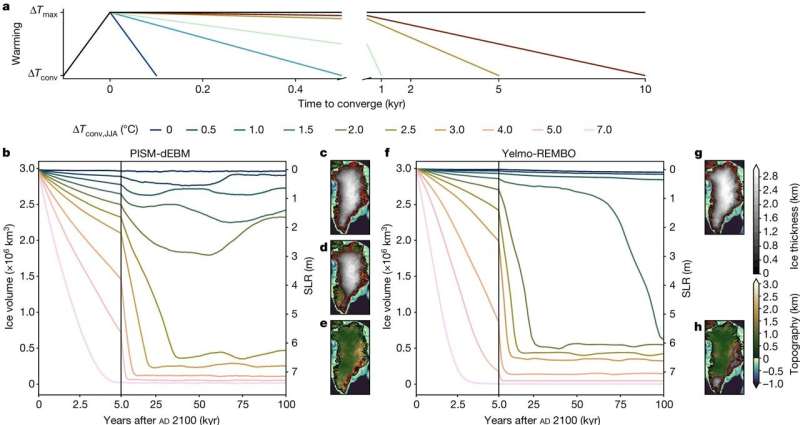Climate research: How the Greenland ice sheet can still be saved

Greenland is the second largest permanently ice-covered surface on the Earth; only Antarctica is larger. The Greenland ice sheet is drastically impacted by the effects of climate change. If the ice sheet melts completely it would cause a sea level rise of more than seven meters—a catastrophe for coastal regions worldwide and for the people who live there.
The critical threshold for the worst-case scenario is between 1.7 and 2.3 degrees Celsius of global warming above the preindustrial level on an annual average. Until now climate research has assumed that if this point is exceeded, the Greenland ice sheet would be lost forever. However, the international research team has now been able to show in a large set of simulations that there would be a way back after passing the tipping point.
Irreversible damage to the ice sheet are avoidable
Niklas Boers is Professor of Earth System Modeling at TUM and member of the Potsdam Institute for Climate Impact Research (PIK). Together with scientists from UiT The Arctic University of Tromsø and the Complutense University of Madrid, he has succeeded in proving that the tipping point for the Greenland ice sheet can temporarily be exceeded without irreversible damage.
"Our simulations have shown us that it is possible to stop the melting of Greenland's ice sheet in spite of failure to meet climate goals and to even reverse the process. Here the important thing is that if the tipping point is exceeded, massive countermeasures would be necessary and the Earth would have to be cooled down to below the critical values," says Prof. Niklas Boers.
No green light for 'more business as usual'
However, the new findings do not mean that society can be satisfied with its climate protection achievements to date; instead the findings are to be seen much more as a second chance and an outlook for the future. In the simulation the researchers used two different ice sheet models. A large number of scenarios were run, with global warming between 1.5 and 6.5 degrees Celsius until 2100 and a subsequent cooling phase of between 100 to 10,000 years.
"Using super-computers we were able to calculate this enormous number of scenarios reaching 100,000 years into the future so that we could be completely certain that the Greenland ice sheet is in balance. However, in both ice sheet models we were able to show that the ice sheet can recover, as long as the critical temperature threshold value is only exceeded for a limited period of time of several centuries," says Nils Bochow, scientist at UiT and also member of PIK.
Recovery possible, but only with concerted action
The prerequisite for recovery of the ice sheet is the prompt correction of the temperature on the Earth in a time frame of about 500 years, depending on how far the maximum temperatures rise above the critical values. The speed, drastic nature, effort and expense of the countermeasures necessary for cooling the Earth will increase with the time the tipping point is exceeded and the increase in temperature during that time.
Drastic measures include massive reduction in atmospheric CO2 concentrations on the entire planet and thereby reducing global temperatures, using technologies like wide-scale re- and aforestation and carbon capture and storage. The scientists' calculations indicate that countermeasures will not have to be as extreme if global warming only slightly exceeds the targets defined in the Paris Climate Accord. The new findings are thus a sign of hope in the search for a way to stop climate change before our last chance is gone.
The work is published in the journal Nature.
More information: Nils Bochow, Overshooting the critical threshold for the Greenland ice sheet, Nature (2023). DOI: 10.1038/s41586-023-06503-9. www.nature.com/articles/s41586-023-06503-9
Journal information: Nature
Provided by Technical University Munich The Greenland Ice Sheet is close to a melting point of no return, says new study
No comments:
Post a Comment